Evaluation of CADI Low Alloyed with Chromium for Camshafts Application
Abstract
:1. Introduction
2. Materials and Methods
2.1. Casting of Ductile Iron Camshafts
2.2. Austempering Heat Treatments
2.3. Microstructural Characterization
2.4. Mechanical Properties
3. Results
3.1. Chemical Composition
3.2. Microstructural Characterization of Ductile Irons
3.3. Microstructural Characterization of CADIs
3.4. Volume Fraction of High-Carbon Austenite
3.5. Mechanical Properties of DIs and CADIs
3.5.1. Rockwell C Hardness
3.5.2. Tensile Test
3.5.3. Charpy Impact Energy
3.5.4. Wear Resistance
4. Conclusions
- The amounts of copper, manganese, and chromium added to the cast alloys allow for obtaining graphite nodules in a matrix, constituted mainly of pearlite and carbides. The highest carbide formation is located at the middle of the lobes, due to the inverse chill effect, where the carbide-forming elements (Mn and Cr) increase their concentration in the last liquid to solidify.
- The volume fraction of carbides was increased from 0.65 to 2.87%, when the chromium amount was increased from 0.2 to 0.4 wt%, and they were not dissolved during the austenitizing heat treatment.
- A microstructure constituted by fine ausferrite and carbides was obtained for both CADIs austempered to 265 °C, while coarse ausferrite and carbides were obtained for CADIs heat-treated to 305 °C.
- The process window was obtained by hardness measurements and the volume fraction of high-carbon austenite determination. The PW occurs in the range from 90 to 120 min of austempering heat treatment. The highest VγHC was obtained for the austempering time of 90 min for both CADIs alloyed with 0.2 and 0.4 wt% Cr, as well as for the highest austempering temperature.
- The desired mechanical properties of high hardness and wear resistance for a CADI were achieved for the higher chromium content, where the hardness (49 HRC) and wear resistance (0.316 mm3) were the highest. The sample CADI-0.4Cr-265 meets these requirements. However, the toughness (11 J) and strength (920 MPa) of the camshaft were decreased.
Author Contributions
Funding
Informed Consent Statement
Data Availability Statement
Acknowledgments
Conflicts of Interest
Appendix A

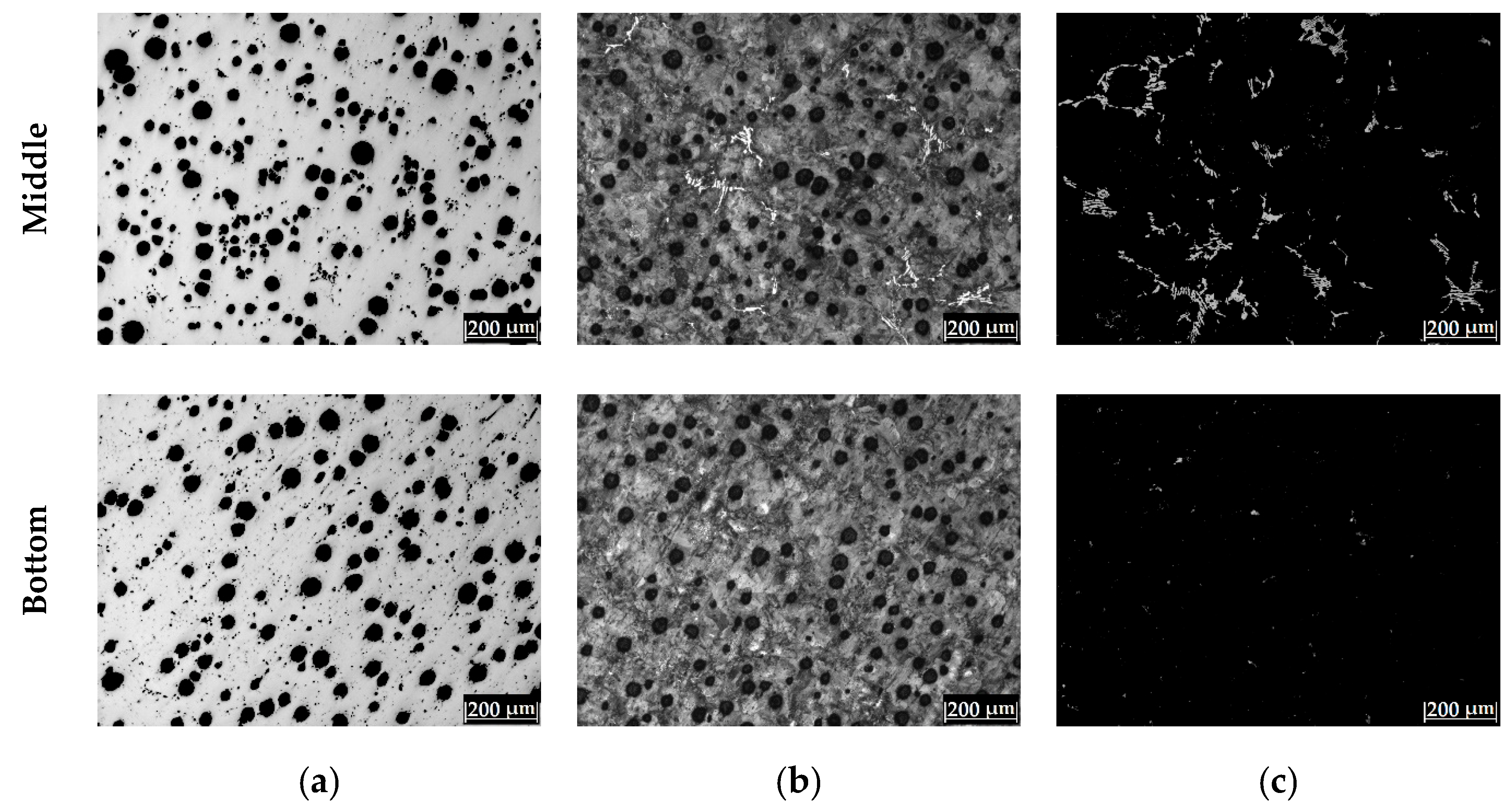
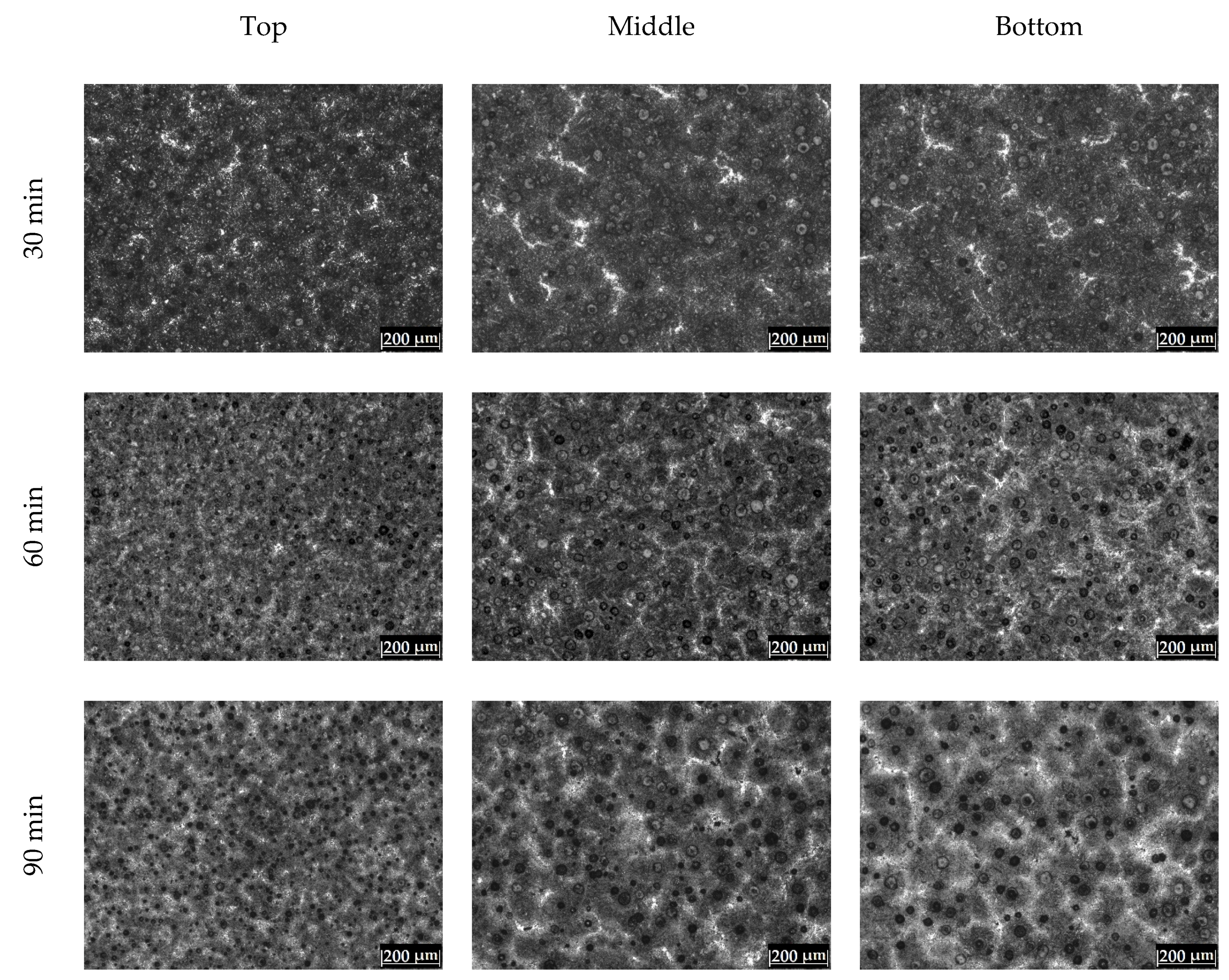


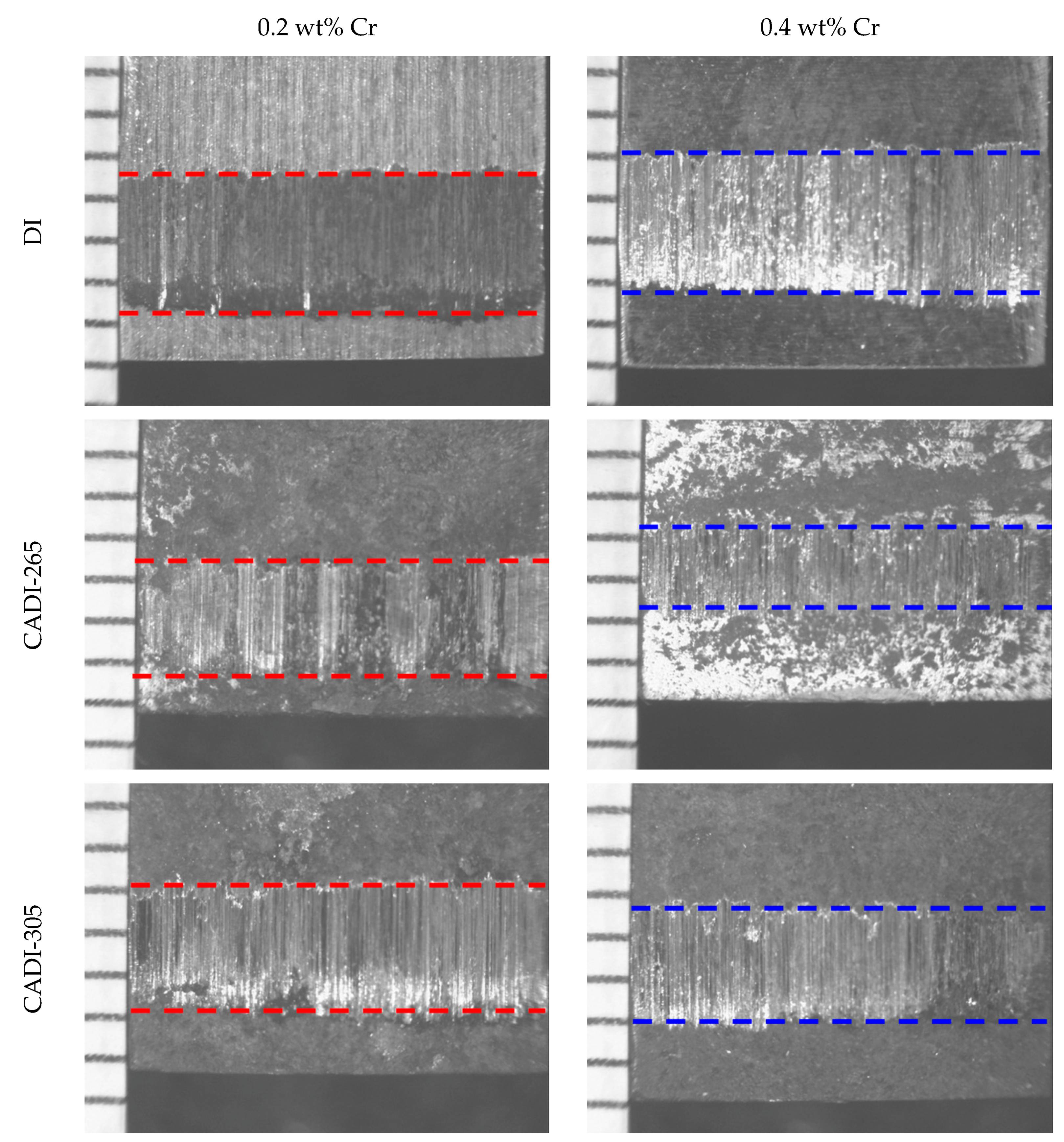
References
- Wang, B.; Barber, G.C.; Tao, C.; Sun, X.; Ran, X. Characteristics of tempering response of austempered ductile iron. J. Mater. Technol. 2018, 7, 198–202. [Google Scholar] [CrossRef]
- Samaddar, S.; Das, T.; Chowdhury, A.K.; Singh, M. Manufacturing of engineering components with austempered ductile iron—A review. Mater. Today Proc. 2018, 5, 25615–25624. [Google Scholar] [CrossRef]
- Gawhare, S.; Harne, M.; Patil, S. Effect of chemical composition and austempering temperature on properties of CADI. Int. J. Adv. Tech. Eng. Sci. 2015, 3, 184–193. [Google Scholar]
- Peng, Y.-C.; Jin, H.-J.; Liu, J.-H.; Li, G.-L. Effect of boron on the microstructure and mechanical properties of carbidic austempered ductile iron. Mater. Sci. Eng. A 2011, 529, 321–325. [Google Scholar] [CrossRef]
- Patil, S.A.; Pathak, S.U.; Likhite, A. Development and wear analysis of carbidic austempered ductile iron (CADI). Int. J. Innov. Res. Sci. Eng. Technol. 2014, 3, 9652–9657. [Google Scholar]
- Prasad, R.P.; Putatunda, S.K. Investigations on the fracture toughness of austempered ductile irons austenitized at different temperatures. Mater. Sci. Eng. A 2003, 349, 136–149. [Google Scholar]
- Yescas, M.A.; Bhadeshia, H.K.D.H. Model for the maximum fraction of retained austenite in austempered ductile iron. Mater. Sci. Eng. A 2002, 333, 60–66. [Google Scholar] [CrossRef]
- Swain, S.K.; Panda, R.K.; Mishra, J.P.; Sen, S. Phase investigation of austempered ductile iron. Orissa J. Phys. 2012, 19, 73–80. [Google Scholar]
- Pereloma, E.V.; Anderson, C.S. Microstructure and properties of austempered ductile iron subjected to single and two step processing. Mater. Sci. Technol. 2006, 22, 1112–1118. [Google Scholar] [CrossRef]
- Gazda, A. Analysis of decomposition processes of ausferrite in copper-nickel austempered ductile iron. J. Therm. Anal. Calorim. 2010, 102, 923–930. [Google Scholar] [CrossRef]
- Muralidhara, A.L.; Rao, P.P. Austempering of Nickel-Chromium Alloyed Ductile Irons. AFS Trans. 1988, 94, 387–396. [Google Scholar]
- Bedolla, J.A.; Hernández, H.R.A.; Vapeani, G.F.; Mejia, I. The role of chromium during austempering of ductile iron. Metall. Res. Technol. 2020, 117, 1–10. [Google Scholar]
- Liu, J.; Li, G.; Zhao, X.; Hao, X.; Zhang, J. Effect of austempering on the microstructure and properties of carbidic austempered ductile iron. Adv. Mater. Res. 2011, 284–286, 1085–1088. [Google Scholar] [CrossRef]
- Bayrakceken, H.; Ucun, I.; Tasgetiren, S. Fracture analysis of a camshaft made from nodular cast iron. Eng. Fail. Anal. 2006, 13, 1240–1245. [Google Scholar] [CrossRef]
- Bereteu, L.; Crâştiu, I.; Nyaguly, E.; Simoiu, D. Investigation of a camshaft repaired by welding using the vibration signal analysis. Adv. Mater. Res. 2015, 1111, 199–204. [Google Scholar] [CrossRef]
- Chernyshev, A.N.; Kaplina, I.N.; Serapin, M.I. Surface hardening with remelting of functional surfaces of cast iron camshafts. Met. Sci. Heat Treat. 1996, 38, 440–442. [Google Scholar] [CrossRef]
- Mi, G.; He, B.; Wang, Y. Effect of temperature and inoculation on the structure property of chilled cast iron camshaft. Adv. Mater. Res. 2011, 152–153, 154–158. [Google Scholar] [CrossRef]
- Kumruoğlu, L.C. Mechanical and microstructure properties of chilled cast iron camshaft: Experimental and computer aided evaluation. Mater. Des. 2009, 30, 927–938. [Google Scholar] [CrossRef]
- Lasota, I.; Protsenko, V.; Matyushkin, A.; Kuznetsov, M.; Gook, S. Laser surface hardening of engine camshaft cams. Mater. Today Proc. 2020, 30, 1–5. [Google Scholar] [CrossRef]
- Ogata, P.E.; Dos Santos Filho, D.; Okazaki, L.; Nishikawa, L.P.; Goldenstein, H. A study on the camshaft lobe microstructure obtained by different processing. In Proceedings of the 21st SAE Brasil International Congress and Exhibition, São Paulo, Brazil, 2–4 October 2012. [Google Scholar]
- Karaca, B.; Şimşir, M. The effects of austempering and induction hardening on the wear properties of camshaft made of ductile cast iron. Acta Phys. Pol. 2017, 131, 448–452. [Google Scholar] [CrossRef]
- Colin, G.E.; Cruz, R.A.; Reyes, C.G.; Téllez, R.J.; Magaña, H.A. Microstructural and mechanical assessment of camshafts produced by ductile cast iron low alloyed with vanadium. Metals 2021, 11, 146. [Google Scholar] [CrossRef]
- Colin, G.E.; Cruz, R.A.; Reyes, C.G.; Chávez, A.J.F.; Téllez, R.J.; Magaña, H.A. Heat treatment evaluation for the camshats production of ADI low alloyed with vanadium. Metals 2021, 11, 1036. [Google Scholar] [CrossRef]
- Ruxunda, R.E.; Stefanescu, D.M.; Pinwonka, T.S. Microstructure characterization of ductile thin-wall iron castings. AFS Trans. 2002, 110, 1131–1147. [Google Scholar]
- Miller, R.L. A rapid method for the determination of retained austenite. Trans. ASM 1964, 57, 892–899. [Google Scholar]
- Stefanescu, D.M. Ductile Iron, Control of the Composition of Ductile Iron; Handbook Volume 15 Castings; ASM International: Almere, The Netherlands, 1998; p. 1408. [Google Scholar]
- Bayati, H.; Elliott, R. Austempering process in high manganese alloyed ductile cast iron. Mater. Sci. Technol. 1995, 11, 118–129. [Google Scholar] [CrossRef]
- Sadighzadeh, B.A. Effect of alloying elements on austempered ductile iron (ADI) properties and its process: Review. China Foundry 2015, 12, 54–70. [Google Scholar]
- Colin, G.E.; Cruz, R.A.; Reyes, C.G.; Romero, S.J.A.; Sanchez, A.R.G.; Hernández, C.M. Influence of nickel addition and casting modulus on the properties of hypo-eutectic ductile cast iron. J. Min. Metall. Sect. B Metall. 2019, 55, 115–124. [Google Scholar]
- Resvani, M.; Harding, R.A.; Camplell, J. The effect of vanadium in as-cast ductile iron. Int. J. Cast Met. Res. 1997, 10, 1–15. [Google Scholar] [CrossRef]
- Laino, S.; Sikora, J.A.; Dommarco, R.C. Development of wear resistant carbidic austempered ductile iron. Wear 2008, 265, 1–7. [Google Scholar] [CrossRef]
- Yang, J.; Putatunda, S.K. Improvement in strength and toughness of austempered ductile cast iron by a novel two-step austempering process. Mater. Des. 2004, 25, 219–230. [Google Scholar] [CrossRef]
- Akbarzadeh, C.E.; Iranipour, N.; Yazdani, S. Effect of nodule count and austempering heat treatment on segregation behavior of alloying elements in ductile cast iron. China Foundry 2016, 13, 217–222. [Google Scholar] [CrossRef] [Green Version]
- Jahangiri, M.R.; Nili, A.M.; Farhangi, H. Enhancement of fatigue properties of ductile irons by successive austempering heat treatment. J. Mater. Eng. Perform. 2011, 20, 1642–1647. [Google Scholar] [CrossRef]
- Cekic, O.E.; Sidjanin, L.; Rajnovic, D.; Rajnovic, D.; Balos, S. Austempering kinetics of Cu-Ni alloyed austempered Ductile Iron. Met. Mater. Int. 2014, 20, 1131–1138. [Google Scholar] [CrossRef]
- Putatunda, S.K.; Gadicherla, P.K. Effect of austempering time on mechanical properties of a low manganese austempered ductile iron. J. Mater. Eng. Perform. 2000, 9, 193–203. [Google Scholar] [CrossRef]
- Wang, B.; Barber, G.C.; Qiu, F.; Zou, Q.; Yang, H. A review: Phase transformation and wear mechanisms of single-step and dual-step austempered ductile irons. J. Mater. Res. Technol. 2019, 9, 1054–1069. [Google Scholar] [CrossRef]
- Han, J.M.; Zou, Q.; Barber, G.C.; Nasir, T.; Northwood, D.O.; Sun, X.C.; Seaton, P. Study of the effects of austempering temperature and time on scuffing behavior of austempered Ni-Mo-Cu ductile iron. Wear 2012, 290–291, 99–105. [Google Scholar] [CrossRef]
- Han, C.F.; Sun, Y.F.; Wu, Y.; Ma, Y.H. Effects of Vanadium and Austempering Temperature on Microstructure and Properties of CADI. Metallogr. Microstruct. Anal. 2015, 4, 135–145. [Google Scholar] [CrossRef]
- Han, C.F.; Wang, Q.Q.; Sun, Y.F.; Li, J. Effects of Molybdenum on the Wear Resistance and Corrosion Resistance of Carbidic Austempered Ductile Iron. Metallogr. Microstruct. Anal. 2015, 4, 298–304. [Google Scholar] [CrossRef]
- Colin, G.E.; Cruz, R.A.; Romero, S.J.A.; Sánchez, A.R.G.; Gutiérrez, P.V.H.; Reyes, C.G. Nodule count effect on microstructure and mechanical properties of hypo-eutectic ADI alloyed with nickel. J. Min. Metall. Sect. B Metall. 2021, 57, 115–124. [Google Scholar] [CrossRef]
- Minkoff, I. The Physical Metallurgy of Cast Iron; John Wiley and Sons: Salisbury, UK, 1983; p. 183. [Google Scholar]
- Sun, X.; Wang, Y.; Li, D.Y.; Wang, G. Modification of carbidic austempered ductile iron with nano ceria for improved mechanical properties and abrasive wear resistance. Wear 2013, 301, 116–121. [Google Scholar] [CrossRef]
- Bakhshinezhad, H.; Honarbakhshraouf, A.; Abdollah, P.H. A study of effect of vanadium on microstructure and mechanical properties of as-cast and austempered ductile iron. Phys. Met. Metallogr. 2019, 120, 441–446. [Google Scholar] [CrossRef]
- Ramada, M.; Nofal, A.A.; Elmahalawi, I.; Abdel, K.R. Influence of graphite nodularity on microstructure and processing window of 1.5% Ni-0.3% Mo austempered cast iron. Mater. Sci. Eng. A 2006, 435–436, 564–572. [Google Scholar]
- Likhite, A.; Parhad, P.; Peshwe, D.R.; Pathak, S.U. Effect of Austenitization Temperature on Wear Behavior of Carbidic Austempered Ductile Iron (CADI). Int. Sch. Sci. Res. Innov. 2014, 8, 510–512. [Google Scholar]
- Panneerselvam, P.; Martis, C.J.; Putatunda, S.K.; Boileau, J. An investigation on the stability of austenite in austempered ductile cast iron (ADI). Mater. Sci. Eng. A 2015, 626, 237–246. [Google Scholar] [CrossRef]
- Sun, Y.; Hu, S.; Xiao, Z.; You, S.; Zhao, J.; Lv, Y. Effects of nickel on low-temperature impact toughness and corrosion resistance of high-ductility ductile iron. Mater. Des. 2012, 41, 37–42. [Google Scholar] [CrossRef]
- Nofal, A.A.; Ramadan, M.; Adbel, K.R. Effect of graphite nodularity on structure and properties of austempered cast iron. In Proceedings of the 2002 World Conference of ADI AFS Publication, Louisville, KN, USA, 26–27 September 2002; pp. 15–28. [Google Scholar]
- Da Silva, A.J.S.T.; Goldenstein, H.; Guesser, W.L.; De Campos, M.F. Quenching and partitioning heat treatment in ductile cast irons. Mater. Res. 2014, 17, 115–1123. [Google Scholar] [CrossRef] [Green Version]
- Zhou, W.S.; Zhou, Q.D. Lubricated sliding and rolling wear of austempered ductile iron. Wear 1993, 162–164, 696–702. [Google Scholar] [CrossRef]
- Sellamuthu, P.; Harris Samuel, D.G.; Dinakaran, D.; Premkumar, V.P.; Li, Z.; Seetharaman, S. Austempered ductile iron (ADI): Influence of austempering temperature on microstructure, mechanical and wear properties and energy consumption. Metals 2018, 8, 53. [Google Scholar] [CrossRef] [Green Version]
- Yang, Y.; Rosochowski, A.; Wang, X.; Jiang, Y. Mechanism of “black line” formation in chilled cast iron camshafts. J. Mater. Process. Technol. 2004, 145, 264–267. [Google Scholar] [CrossRef]



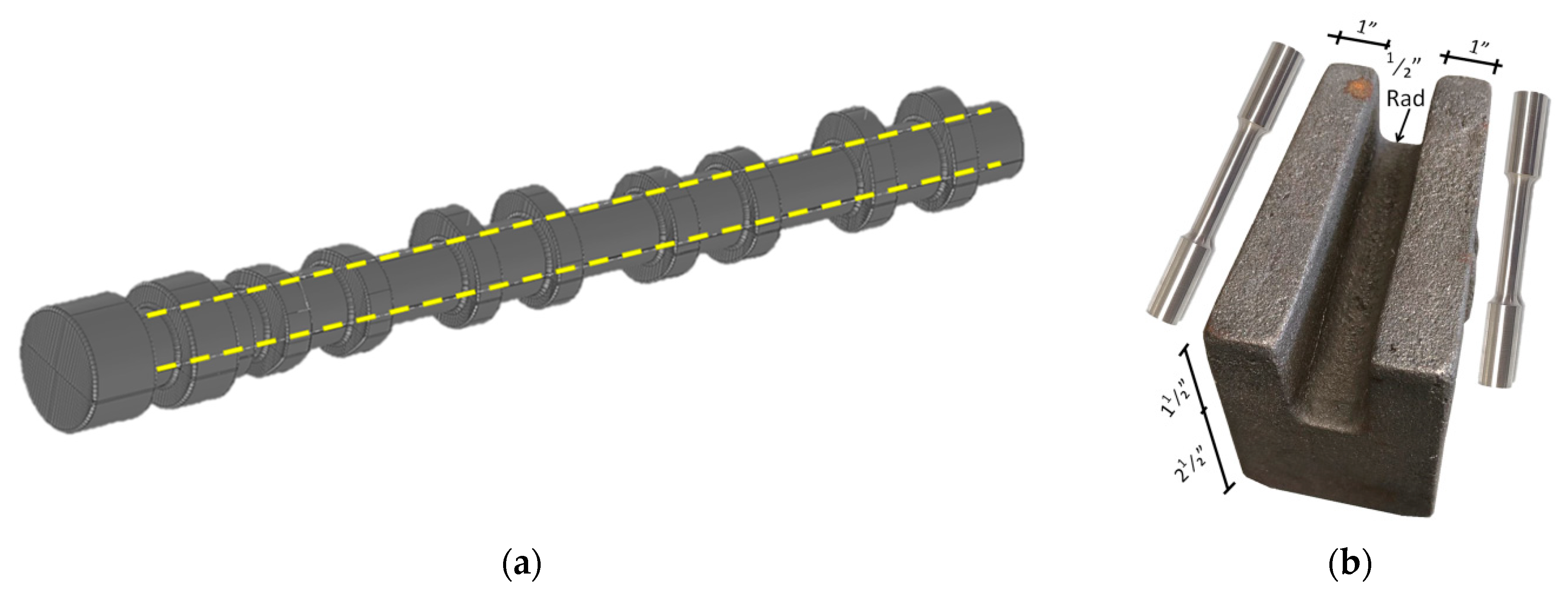

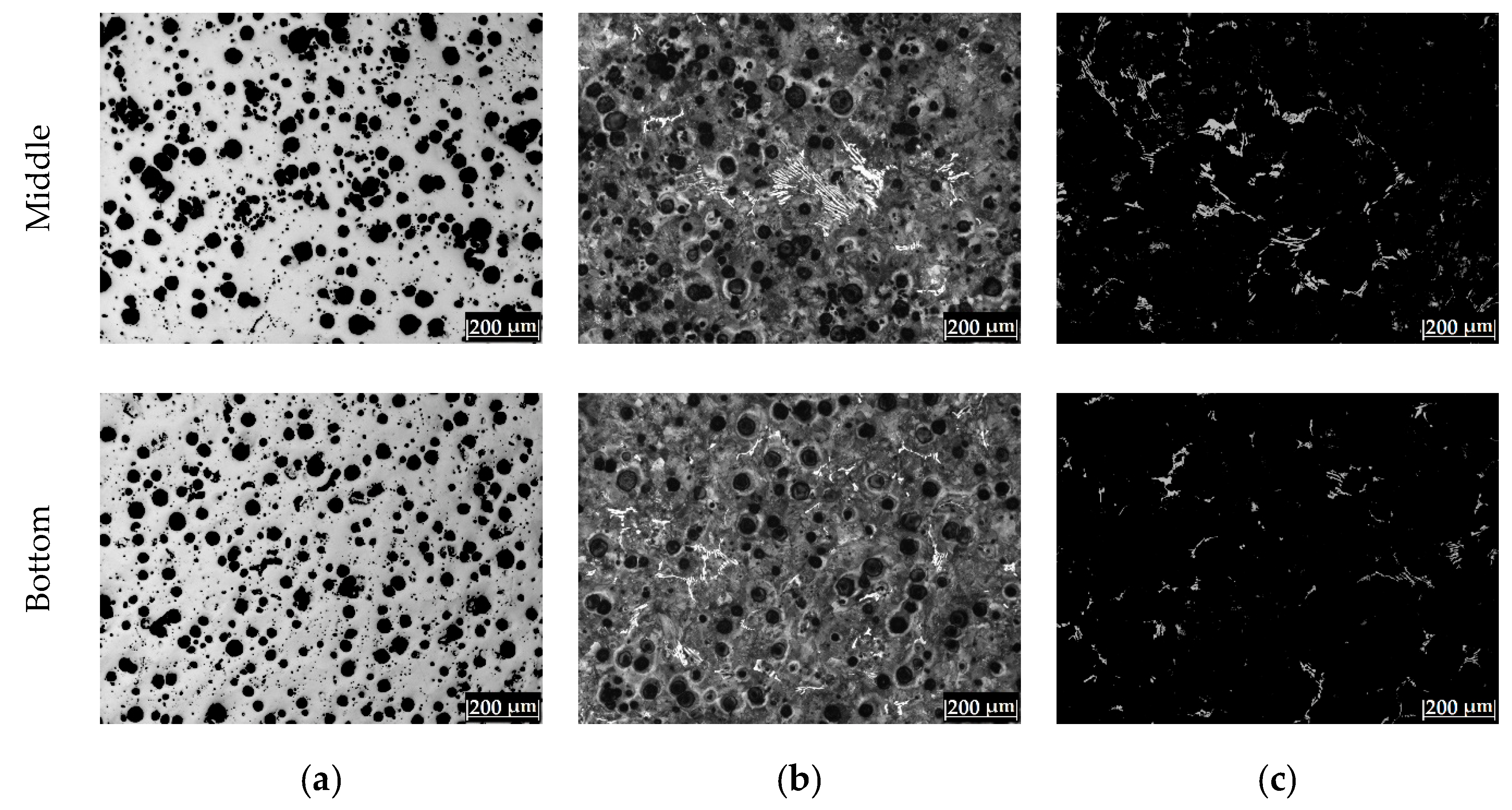
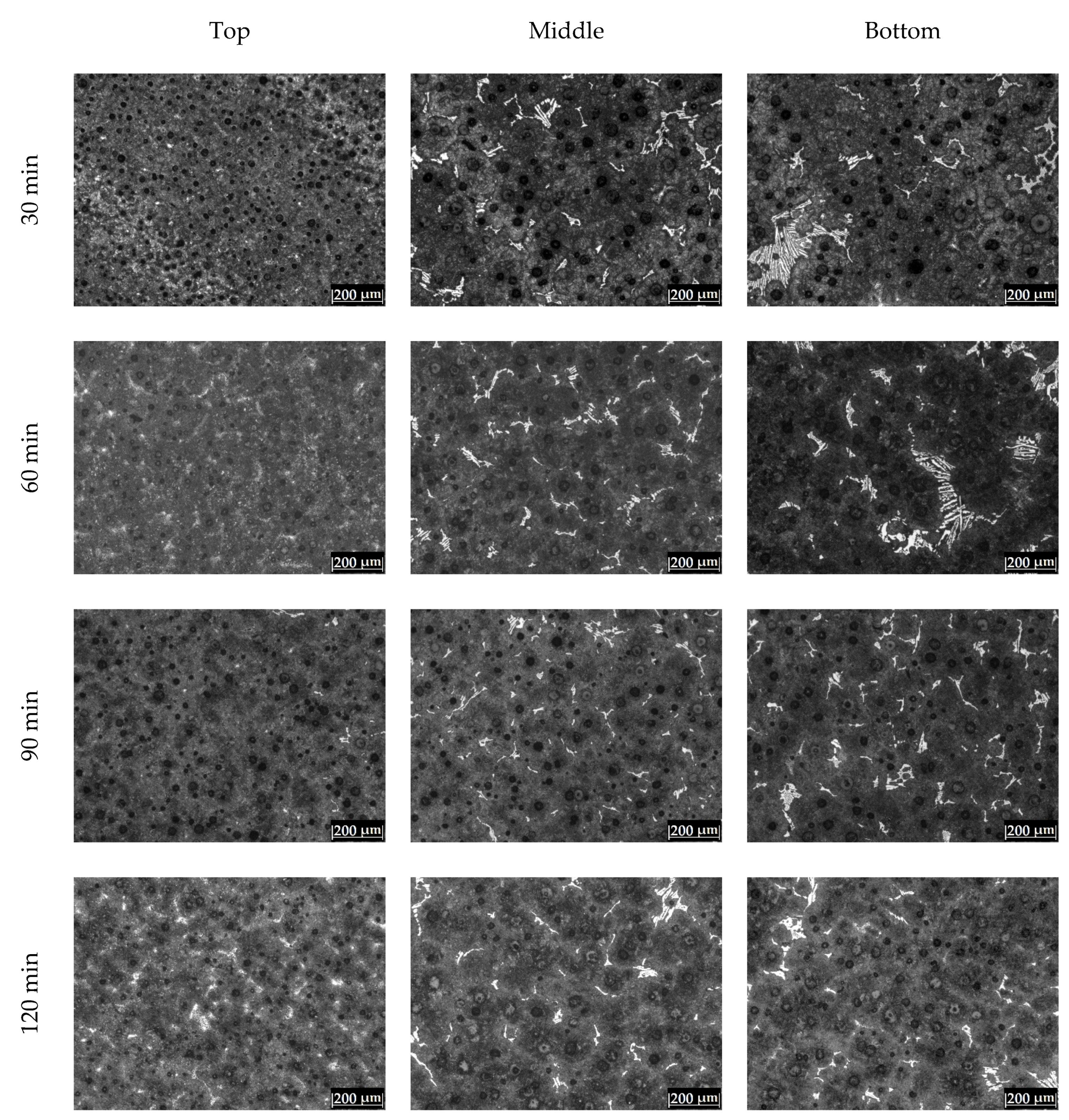


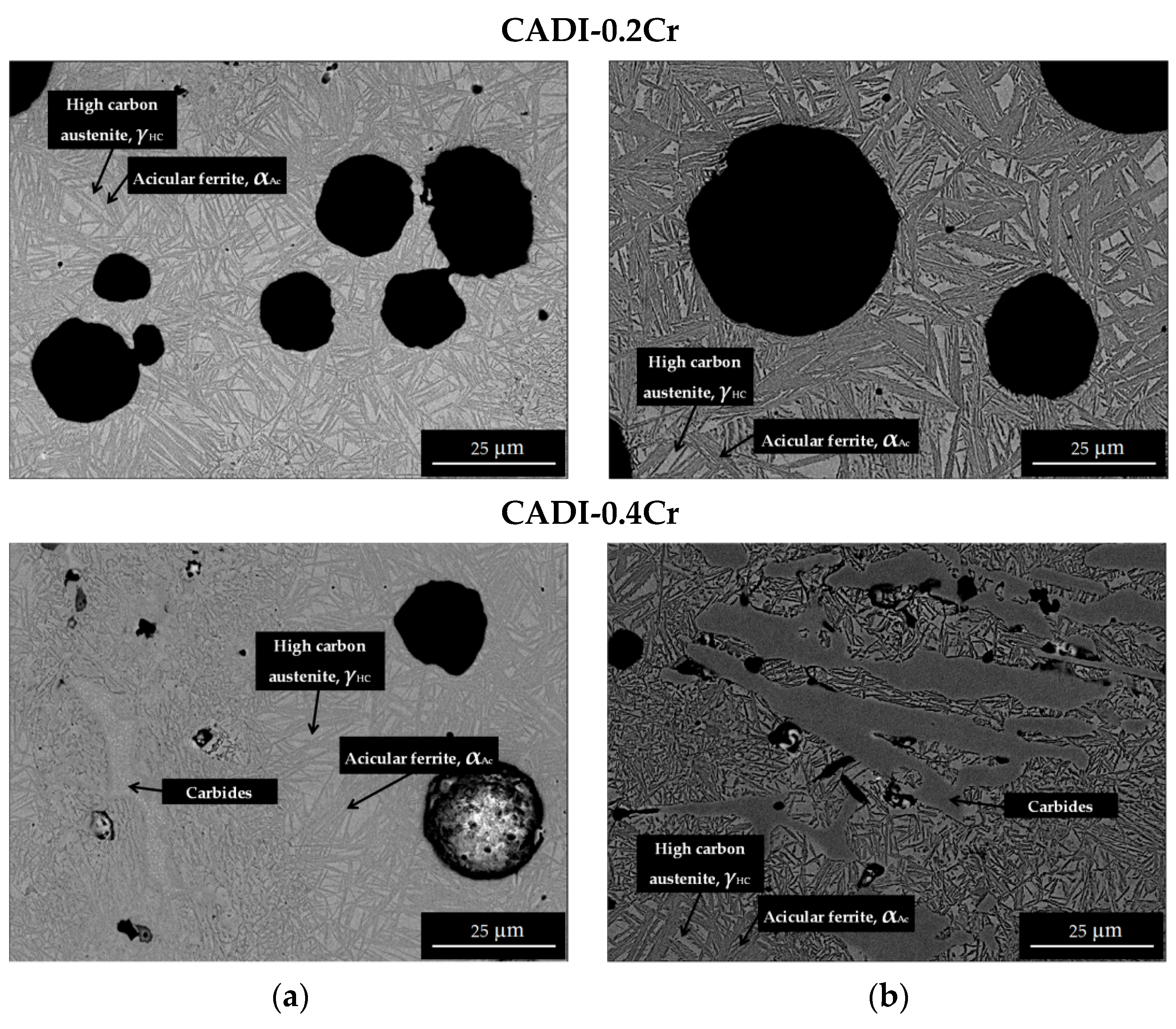

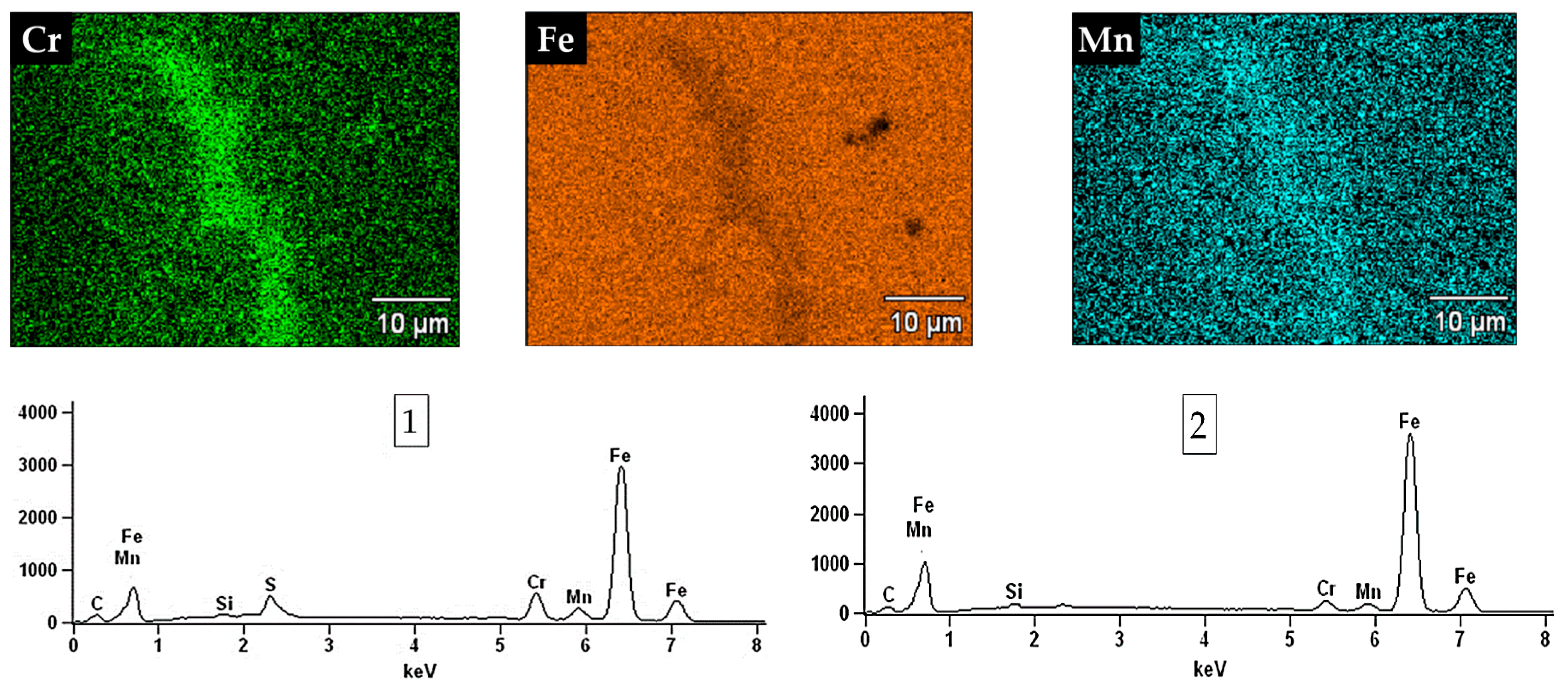

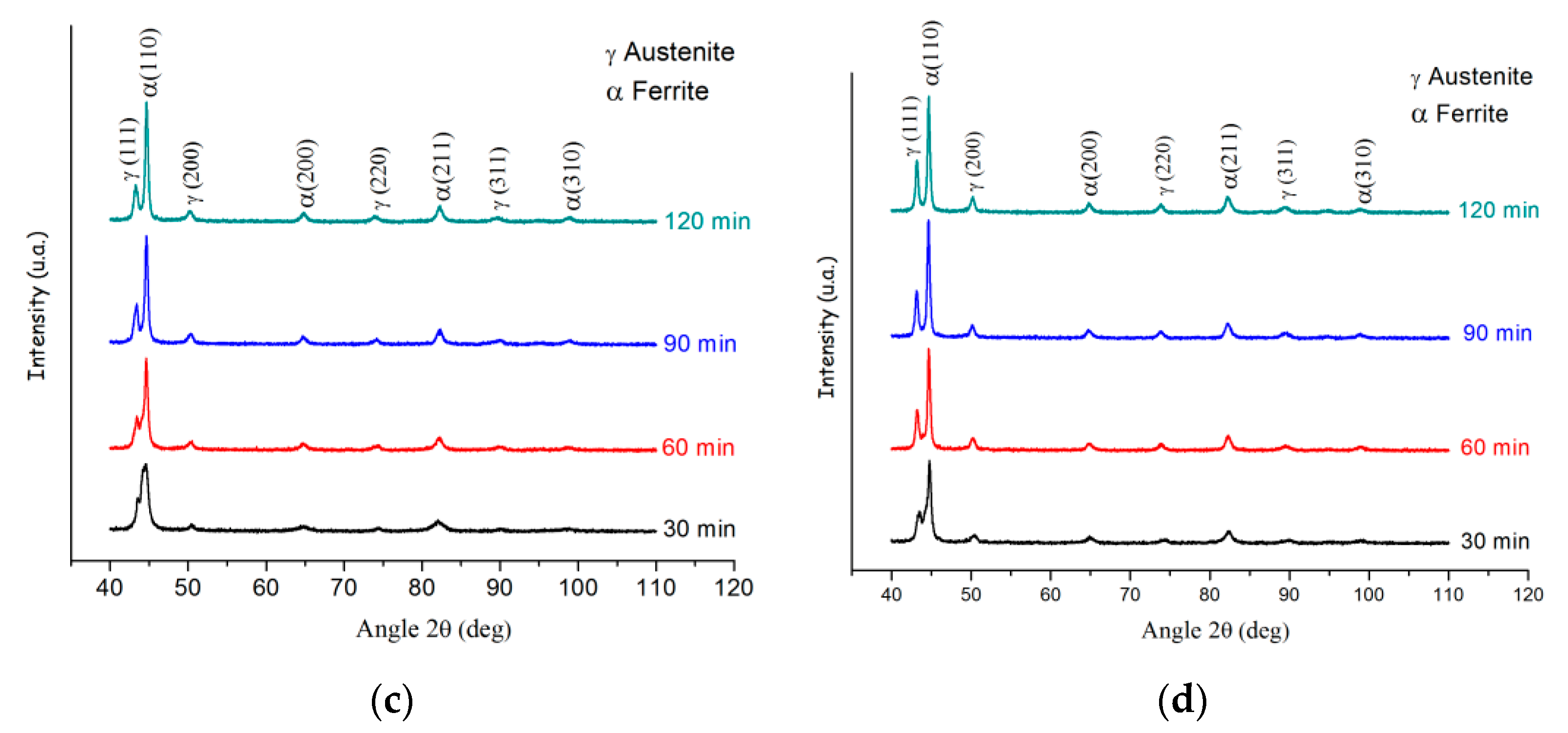

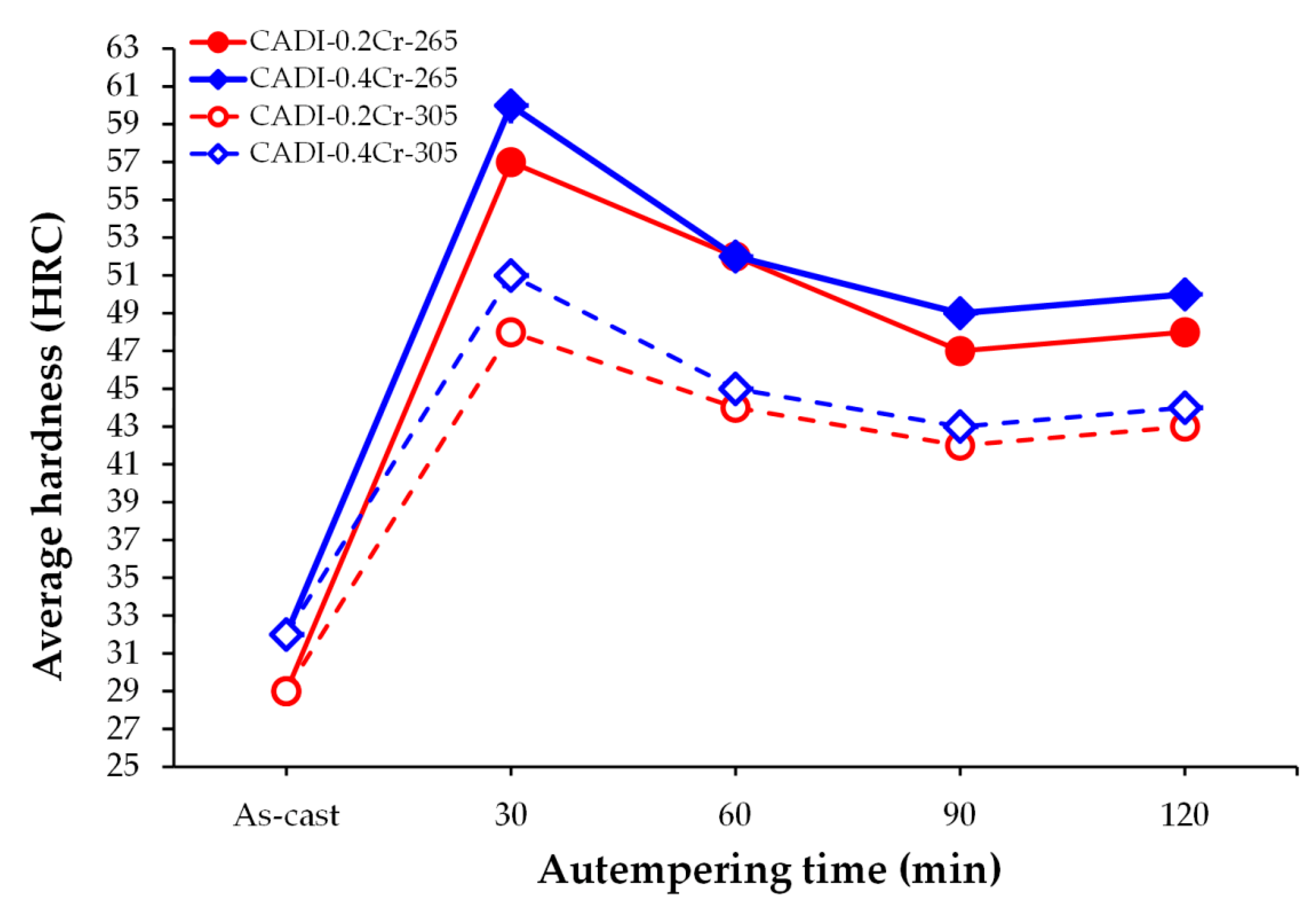
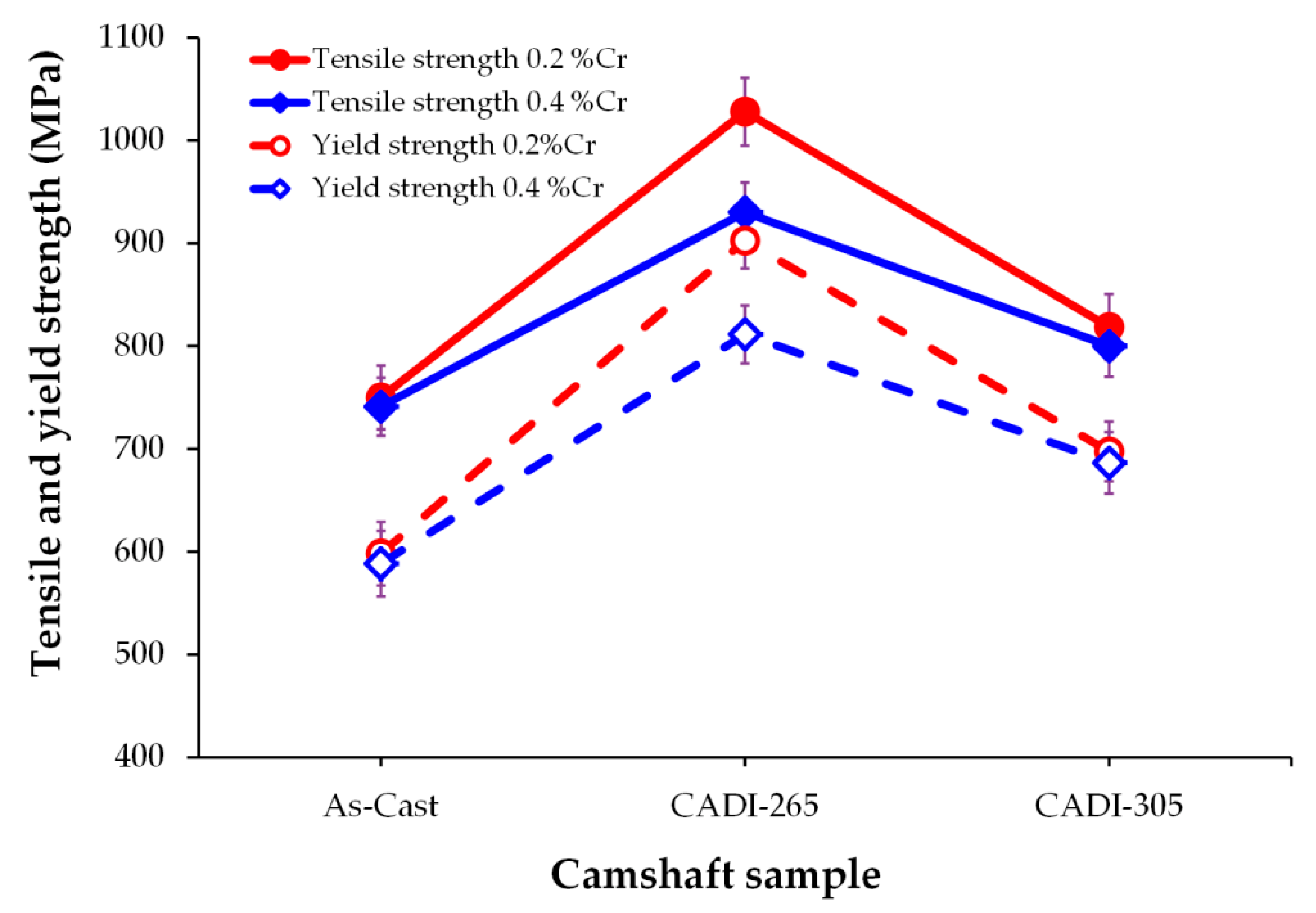
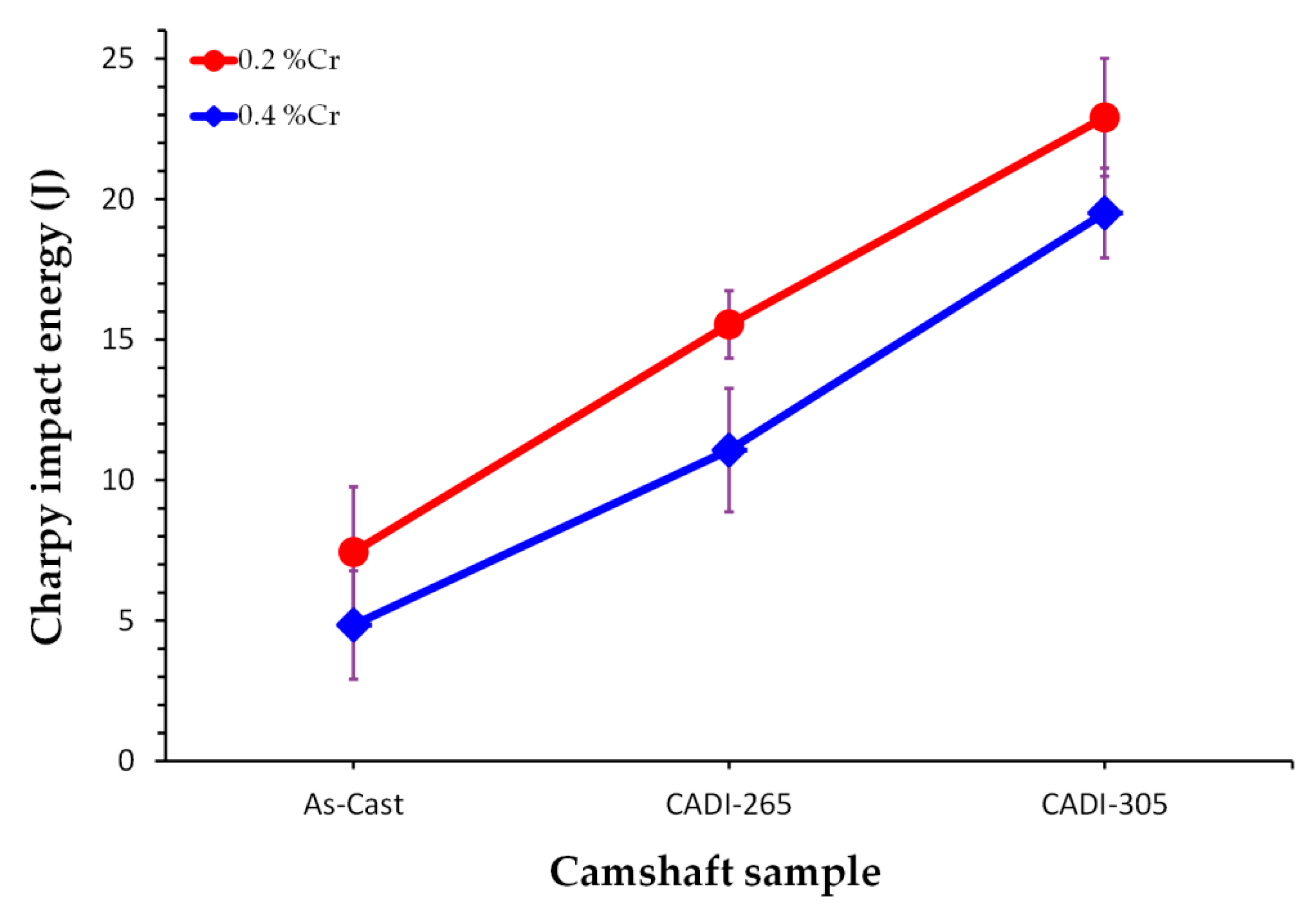
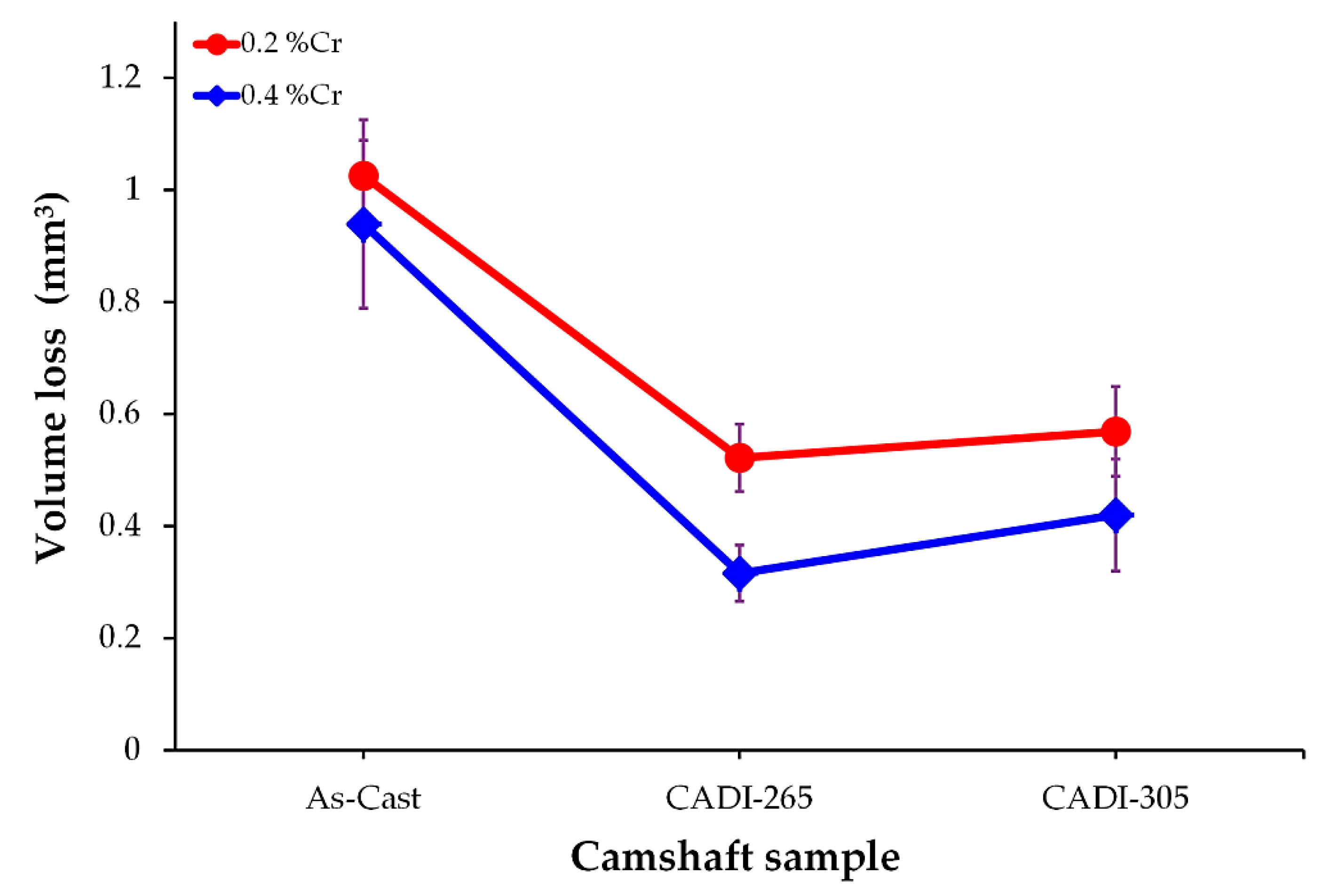
| Sample | C | Si | Mn | P | S | Mg | V | Cr | Ni | Al | Cu | Mo | CE 1 |
|---|---|---|---|---|---|---|---|---|---|---|---|---|---|
| DI-U | 3.61 | 2.36 | 0.83 | 0.015 | 0.008 | 0.046 | 0.008 | 0.043 | 0.103 | 0.013 | 0.879 | 0.03 | 4.40 |
| DI-0.2Cr | 3.64 | 2.41 | 0.94 | 0.015 | 0.013 | 0.047 | 0.011 | 0.23 | 0.114 | 0.014 | 0.961 | 0.093 | 4.44 |
| DI-0.4Cr | 3.56 | 2.47 | 0.94 | 0.016 | 0.013 | 0.048 | 0.010 | 0.42 | 0.118 | 0.014 | 0.954 | 0.095 | 4.38 |
| Characteristics | DI-U | DI-0.2Cr | DI-0.4Cr |
|---|---|---|---|
| Nodularity (%) | 85.17 ± 2.64 | 75.04 ± 1.61 | 71.30 ± 3.31 |
| Nodule count (particles/mm2) | 155 ± 28.67 | 223.38 ± 26.15 | 283.54 ± 17.50 |
| Nodule size (µm) | 32.49 ± 3.69 | 29.06 ± 1.79 | 27.24 ± 3.02 |
| Graphite (%) | 12.84 ± 0.55 | 14.57 ± 1.25 | 17.04 ± 1.97 |
| Ferrite (%) | 5.3 ± 0.20 | 0.33 ± 0.18 | 1.56 ± 0.19 |
| Pearlite (%) | 81.70 ± 0.20 | 84.45 ± 0.30 | 78.53 ± 0.24 |
| Carbides (%) | 0.156 ± 0.04 | 0.65 ± 0.12 | 2.87 ± 0.92 |
| Mechanical Properties | DI-U | DI-0.2Cr | DI-0.4Cr |
|---|---|---|---|
| Hardness (HRC) | 28 ± 2.31 | 29 ± 3.02 | 33 ± 1.27 |
| Tensile Strength (MPa) | 735 ± 32 | 750 ± 28 | 741 ± 35 |
| Elongation (%) | 5.42 ± 0.63 | 4.44 ± 0.56 | 3.6 ± 0.45 |
| Impact Energy (J) | 9.3 ± 1.41 | 7.44 ± 2.33 | 4.85 ± 1.93 |
| Wear resistance (mm3) | 1.25 ± 0.18 | 1.02 ± 0.14 | 0.939 ± 0.23 |
| Sample | Hardness (HRC) | ||||
|---|---|---|---|---|---|
| CADI-0.2Cr-265 | 29 ± 3.02 | 57 ± 0.63 | 52 ± 0.63 | 47 ± 0.11 | 48 ± 0.81 |
| CADI-0.4Cr-265 | 33 ± 1.27 | 60 ± 0.51 | 52 ± 1.09 | 49 ± 0.51 | 50 ± 1.03 |
| CADI-0.2Cr-305 | 29 ± 3.02 | 48 ± 0.52 | 44 ± 0.26 | 42 ± 0.83 | 43 ± 0.63 |
| CADI-0.4Cr-305 | 33 ± 1.27 | 51 ± 0.13 | 45 ± 0.51 | 43 ± 0.40 | 44 ± 0.81 |
| Time (min) | As-cast | 30 min | 60 min | 90 min | 120 min |
| Sample | σo (MPa) | σUTS (MPa) | Hardness (HRC) | Impact Energy (J) | Volume Loss (mm3) |
|---|---|---|---|---|---|
| CADI-0.2Cr-265 | 902 | 1027 | 47 | 15.54 | 0.522 |
| CADI-0.4Cr-265 | 811 | 920 | 49 | 11.07 | 0.316 |
| CADI-0.2Cr-305 | 697 | 818 | 42 | 22.91 | 0.569 |
| CADI-0.4Cr-305 | 686 | 800 | 43 | 19.51 | 0.42 |
Publisher’s Note: MDPI stays neutral with regard to jurisdictional claims in published maps and institutional affiliations. |
© 2022 by the authors. Licensee MDPI, Basel, Switzerland. This article is an open access article distributed under the terms and conditions of the Creative Commons Attribution (CC BY) license (https://creativecommons.org/licenses/by/4.0/).
Share and Cite
Cruz Ramírez, A.; Colin García, E.; Chávez Alcalá, J.F.; Téllez Ramírez, J.; Magaña Hernández, A. Evaluation of CADI Low Alloyed with Chromium for Camshafts Application. Metals 2022, 12, 249. https://doi.org/10.3390/met12020249
Cruz Ramírez A, Colin García E, Chávez Alcalá JF, Téllez Ramírez J, Magaña Hernández A. Evaluation of CADI Low Alloyed with Chromium for Camshafts Application. Metals. 2022; 12(2):249. https://doi.org/10.3390/met12020249
Chicago/Turabian StyleCruz Ramírez, Alejandro, Eduardo Colin García, José Federico Chávez Alcalá, Jaime Téllez Ramírez, and Antonio Magaña Hernández. 2022. "Evaluation of CADI Low Alloyed with Chromium for Camshafts Application" Metals 12, no. 2: 249. https://doi.org/10.3390/met12020249
APA StyleCruz Ramírez, A., Colin García, E., Chávez Alcalá, J. F., Téllez Ramírez, J., & Magaña Hernández, A. (2022). Evaluation of CADI Low Alloyed with Chromium for Camshafts Application. Metals, 12(2), 249. https://doi.org/10.3390/met12020249









